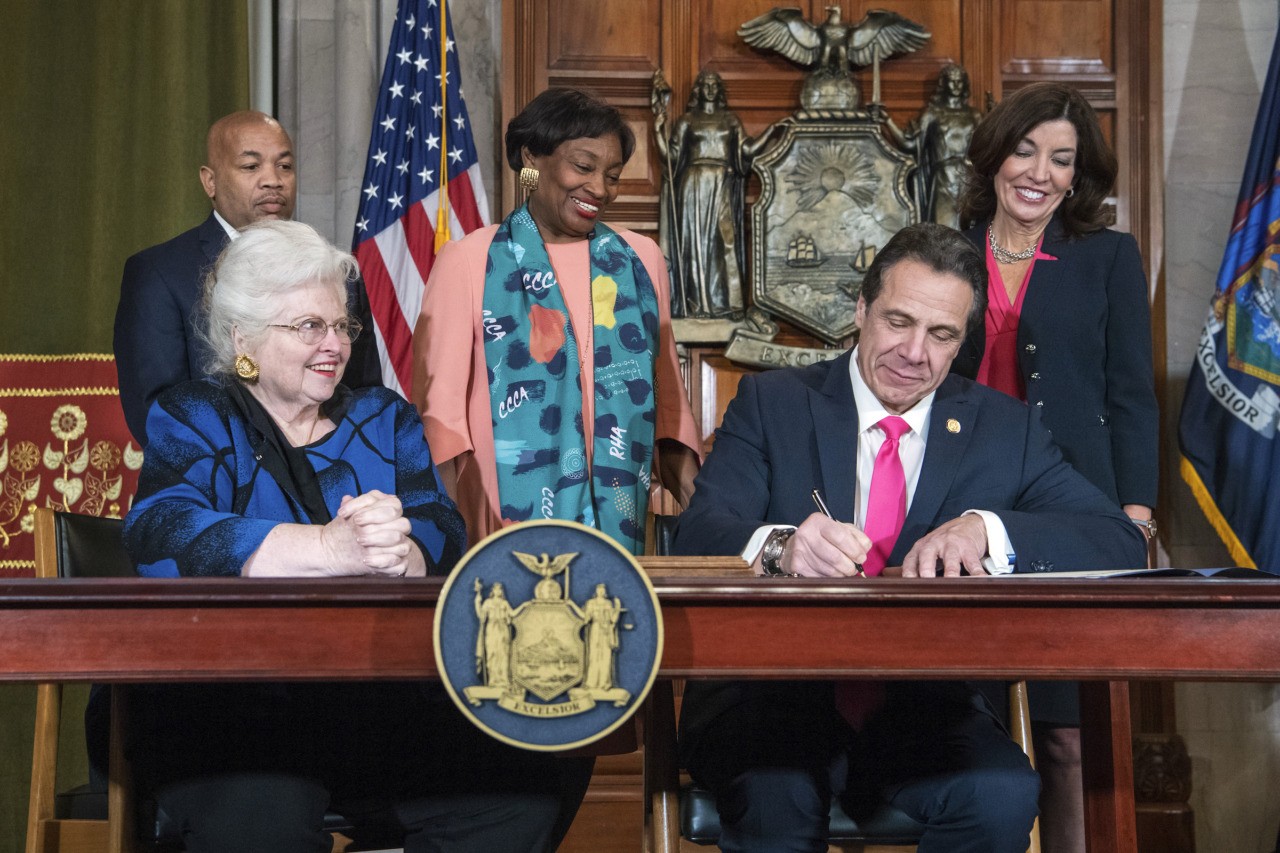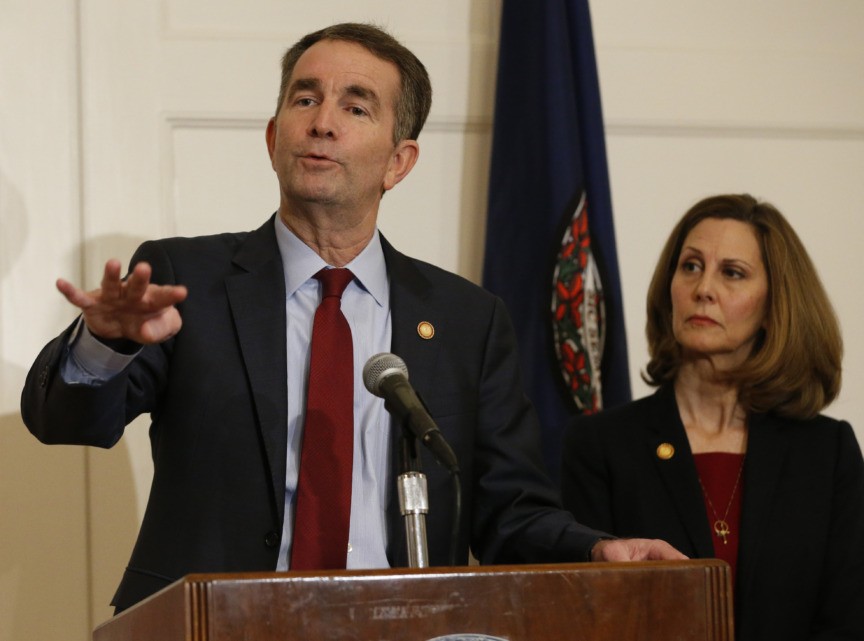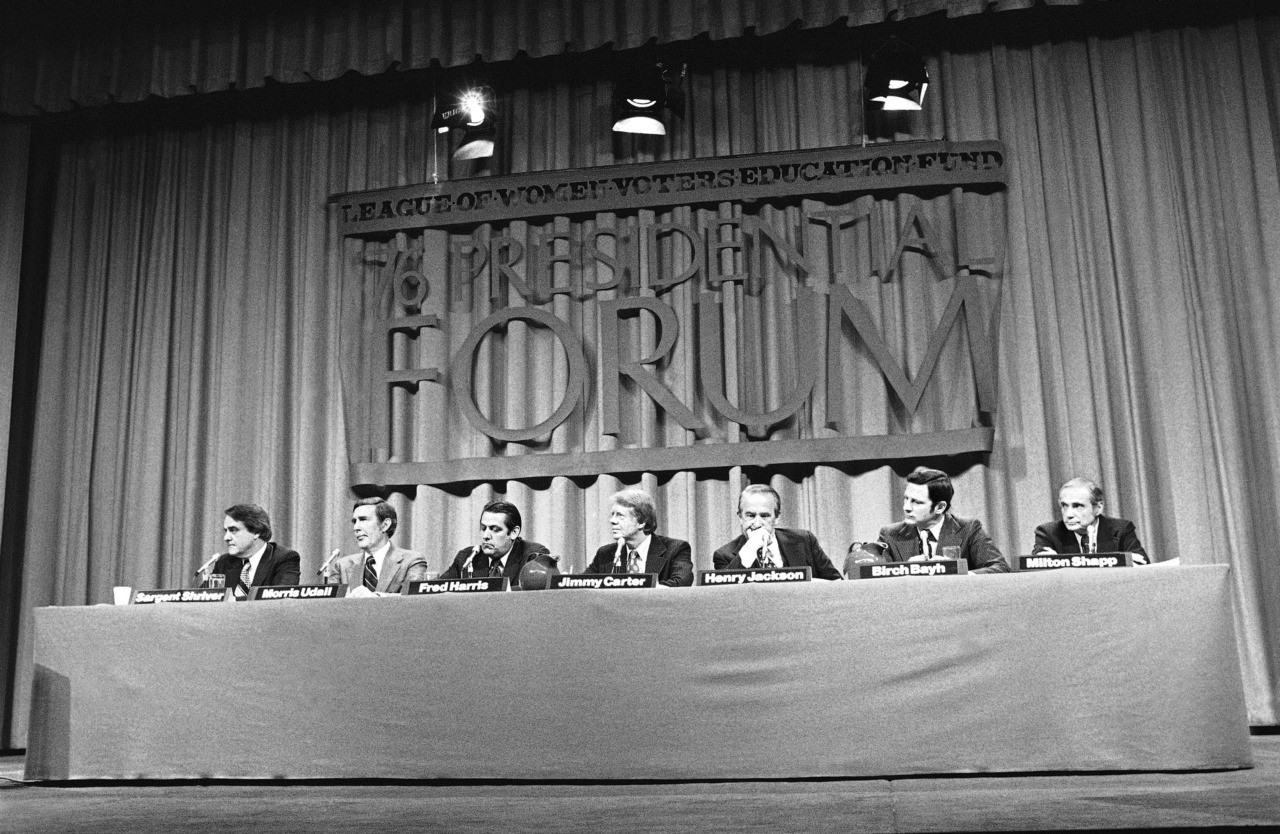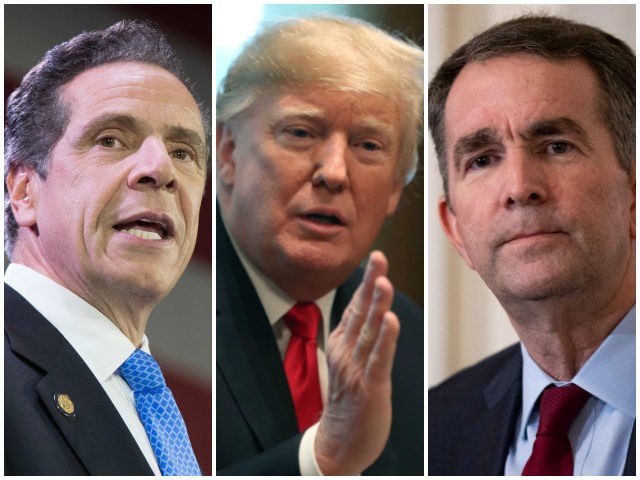Cuomo and Northam Start a Chain Reaction
To put it mildly, throughout his public career, Donald Trump has not always been seen as a champion of the pro-life cause. However, his career is not over yet—and in fact, a sudden cascade of events is making him into a pro-life stalwart, as the Right to Life movement makes its biggest comeback in decades.
Ironically, the renewed prominence of the anti-abortion cause has been the doing of pro-abortion Democrats. On January 22, New York governor Andrew Cuomo signed into law the Reproductive Health Act, which fully allows for abortions after 24 weeks of pregnancy; that is, right up to the moment of birth. Critics dubbed the bill “infanticide,” recalling the words of former New York’s former Democratic senator, Daniel Patrick Moynihan, who, back in the 1990s, said that such a procedure “is as close to infanticide as anything I have come upon.” (On February 6, Breitbart News’ Dr. Susan Berry updated the New York story.)

Gov. Andrew Cuomo (D-NY) signs the nation’s most extensive abortion rights legislation into, on Jan. 22, 2019, at the State Capitol in Albany, NY. (Darren McGee/Office of Gov. Andrew M. Cuomo via AP)
Then, on January 30, Virginia Governor Ralph Northam praised a similar abortion bill being debated his state’s legislature, indicating that he would be happy to sign it. (The bill failed.)
Taken together, the deeds and words of Cuomo and Northam crossed a line in American public opinion. That is, most Americans seem to be uneasily okay with some amount of legal abortion, and yet at the same time, they don’t support “abortion on demand.” As the Gallup Poll observed in June:
When asked more specifically about their views on the legality of abortion, half of Americans adopt a middle-of-the-road position, saying abortion should be legal “only under certain circumstances.”
Yet in the face of this cautious public view, Cuomo and Northam were embracing abortion under all circumstances. This anything-goes view was just too much; many reporters and pundits felt a lifeward twinge. After all, for the bulk of Americans, abortion is never a happy choice; the Gallup data reflect that, too:
By a slim five-percentage-point margin, 48% to 43%, Americans believe abortion is wrong from a moral perspective. In fact, abortion is the moral issue among those tested on which the public is most closely divided.
So now the pro-life forces, including Trump, had their opening. As Trump said of Northam on January 30, “Do you remember when I said Hillary Clinton was willing to rip the baby out of the womb? That’s what it is. That’s what they’re doing. It’s terrible.”
As we all know, for Northam, the controversy grew worse just two days later, on February 1, when it was revealed that he had worn blackface, or dressed up as a Klansman, or used racial epithets—or all of the above. Intriguingly, there was a direct connection between the new revelations and his earlier comments about abortion; as one source told The Washington Post, “The revelations about Ralph Northam’s racist past were absolutely driven by his medical school classmate’s anger over his recent very public support for infanticide.” To pro-lifers, of course, this sequence, likely to lead to Northam’s downfall, is proof that justice does, indeed, reign supreme.

Gov. Ralph Northam (D-VA), left, and his wife, Pam, at a press conference on Saturday, Feb. 2, 2019, to address the controversial surrounding a racist photo in his college yearbook. (AP Photo/Steve Helber)
In the meantime, on February 2, Tweeter-in-Chief was on the hunt:
What a Difference a Year Makes
So now the abortion issue is back. Just a year ago, it didn’t seem that the abortion issue would play out this way. Indeed, it didn’t seem as though the abortion issue would be playing at all. For instance, in his 2018 State of the Union address, Trump made no mention of the words “abortion” or “life,” as in, “right to life.”
Yet in the wake of Cuomo and Northam, Trump has been all over the life issue. In in his 2019 State of the Union, his rhetoric was stark:
There could be no greater contrast to the beautiful image of a mother holding her infant child than the chilling displays our nation saw in recent days. Lawmakers in New York cheered with delight upon the passage of legislation that would allow a baby to be ripped from the mother’s womb moments before birth. These are living, feeling, beautiful babies who will never get the chance to share their love and dreams with the world. And then, we had the case of the governor of Virginia where he stated he would execute a baby after birth.

President Trump delivers his State of the Union, Tuesday, Feb. 5, 2019. (AP Photo/Andrew Harnik)
Needless to say, not everyone agrees with Trump; during Trump’s oration, most Democrats in the audience sat stone-faced. One notable exception was Sen. Joe Manchin of West Virginia, who stood up and applauded; he later explained, “Late term abortions are just horrific … totally just wrong.”
In the meantime, politics-minded Republicans celebrated the opening of a new wedge issue, the contrast between Trump and the #Resistance Democrats. As Beltway insider Mike Allen explained, “Republicans love the freeze frame of Democrats sitting emotionlessly when Trump railed against late-term abortions.”
As for Trump, he’s keeping up the pressure. At the National Prayer Breakfast on February 7, he declared: “All children, born and unborn, are made in the holy image of God.” And he renewed his call for a ban on late-term abortions.
In fact, many Republicans on Capitol Hill have been pushing such legislation for a long time. One such is Sen. Sasse of Nebraska, author of the Born-Alive Abortion Survivors Protection Act. As he explained on Capitol Hill:
Everyone in this Senate ought to be able to say unequivocally that killing that little baby is wrong. I’m going to ask all 100 senators to come to the floor and be against infanticide. This shouldn’t be complicated.
Actually, it was complicated, at least as far as Senate Democrats were concerned—they blocked the bill.
So the struggle will continue. Indeed, even mainstream Republicans, who usually focus on taxes or defense, are now sensing the new energy in the abortion issue. On February 5, Senate Majority Leader Mitch McConnell sent out a e-mail fundraising blast, and the subject line said it all: “This is barbaric.” The e-mail continued in a strongly pro-life vein:
Recently, two states have shown us what happens when Democrats take the majority. In New York, Democrats passed legislation allowing late-term abortions. In Virginia, the Democratic Governor was unable to even say that newborn baby boys and girls have human rights and that they should be protected from violence.
So we can see: Cuomo and Northam went too far; in pushing abortion to an extreme, they riled up the dormant bear of public opinion. Of course, liberal supporters of abortion, at Planned Parenthood and elsewhere, argue that late-term abortion is exceedingly rare, and that there are usually extenuating circumstances.
To which the rest of us can say: All those defensive points might be true, and yet if they are true, well, that doesn’t mean that the public doesn’t have a legitimate interest in seeing fair-minded lawmaking in order to stamp out abuses and to provide at least some ethical guidance. As with so many ethical questions, the distinctions might be delicate, and yet that doesn’t mean that proper distinctions shouldn’t be made.
So now the abortion issue will be argued out in the electoral arena. The next major elections are the gubernatorial contests in Kentucky, Louisiana, and Mississippi this November; those three states, of course, are good territory for pro-lifers.
Then comes 2020, when the whole nation votes. If we recall one of those Gallup numbers—by 48% to 43%, Americans believe abortion is wrong from a moral perspective—we can see that pro-life Republicans have a narrow, but promising, path to victory.
So how will Democrats, including the 2020 presidential candidates, react? Will they stand with Cuomo and Northam, or will they seek to find some acceptable middle ground?
Political history suggests that the Dems, for their sake, had better look hard for that middle way.
We’ve Been Down This Road Before
This author is old enough to recall another presidential campaign when the abortion issue was suddenly front-and-center. That was way back in 1976, in the first presidential election after the Supreme Court’s Roe vs. Wade decision of 1973. At the time, liberal activists cheered the ruling, and yet Democratic officeholders, mindful of their voters, had less reason to cheer.
In fact, the parallels between then and now are revealing. Back in 1976, the electorate was still processing the new reality of legalized abortion. Some voters loved the ruling, of course, and yet others hated it.
Interestingly, many of those who hated it were American Catholics, who in those days identified overwhelmingly as Democrats. In other words, Roe cross-pressured many Catholics, forcing them to choose between their traditional loyalty to the Democratic Party and their new revulsion toward liberal policies that many Democrats embraced. (Of course, at the same time, many Protestants, who had tended to be Republican, were attracted to this new victory for abortion and “personal freedom”; thus a “big sort” was occurring, as voters reshuffled themselves between the two parties.
And yet understandably, such big sorts make politicians nervous, because then they have to try and learn new tricks to appeal to the voters.)
In the 1976 presidential campaign, the ultimate victor was, of course, Jimmy Carter. And yet Carter had to navigate a tricky map, wending his way past then-numerous pro-life Democrats.

Seven Democratic presidential contenders share a stage in Boston, MA, on the eve of the New Hampshire primary, Feb. 24, 1976. From left: Sargent Shriver, Arizona Rep. Morris K. Udall, former Oklahoma Sen. Fred Harris, former Georgia Gov. Jimmy Carter, Washington Sen. Henry M. Jackson, Indiana Sen. Birch Bayh, and Pennsylvania Gov. Milton Shapp. (AP Photo)
As recorded by Jules Witcover in his 1977 book, Marathon: The Pursuit of the Presidency, 1972-1976, Carter was a master at playing the abortion issue both ways, sounding pro-choice to some audiences and pro-life to other audiences. As Witcover writes:
Carter’s intentional ambiguity on abortion “made the difference between first and second place” in Iowa by preempting the only Catholic candidate, [Sargent] Shriver.
By July 1976, Carter had not only secured the Democratic nomination, but he also enjoyed a commanding lead—no less than 33 points, according to Gallup—over incumbent Republican president Gerald Ford.
Mindful of the delicacy of the abortion issue, the 1976 Democratic platform was somewhat soft-spoken on abortion:
We fully recognize the religious and ethical nature of the concerns which many Americans have on the subject of abortion. We feel, however, that it is undesirable to attempt to amend the U.S. Constitution to overturn the Supreme Court decision in this area.
Yet still, the best efforts of Carter and the Democrats notwithstanding, the abortion issue came into focus, as right-to-life activists figured out that Carter had misled—some would say, conned—them in the primaries. (As an aside, we can observe that the sussing out of the truth is an upside of long campaigns—it’s hard to fool people over a protracted period.) In the meantime, over on the Republican side, Ford had shifted to a strongly pro-life stance.
So now Democratic politicos, having long relied on the Catholic vote, were themselves getting heartburn. In his book, Witcover describes a scene in early September in which a planned Carter event at a Catholic church in North Philadelphia had to be canceled because of anti-abortion protests. Indeed, a group of nuns managed to present Carter with a small white coffin, symbolizing their moral cause. That night, in Scranton, protesters thronged Carter’s hotel, chanting, “Life! Life! Life!”
As The New York Times reported on September 21, 1976:
Jimmy Carter’s campaign strategists would like nothing better than for the abortion issue to vanish. A major problem created by the issue, according to Betty Rainwater, an assistant press secretary of Mr. Carter, is that it gets in the way of Mr. Carter’s efforts to present his views on the issues and to overcome existing stereotypes about him. “We would like to have something else beside those life demonstrations on the evening news shows,” she said.
Ah yes, there is that issue of vivid visuals—babies, coffins, white lilies—getting on the TV news. That’s the impact that clever, as well as heartfelt, politics can have.
Without a doubt, the news pictures had their effect; by October, some polls showed that Carter was actually running behind Ford. In other words, Carter had blown a 33-point lead—and then some.
Of course, in the final November balloting, Carter managed to win, albeit narrowly; his popular-vote margin was about two points.
Interestingly, in the four decades since, the two parties have stayed about evenly divided; of the 11 presidential elections since Roe v. Wade, pro-choice Democrats have won five, and pro-life Republicans have won six. During all those years, abortion has stayed legal, but there’s still that obvious public desire to keep some restrictions in place.
Looking Ahead to 2020
So now, as we look ahead to 2020, we can ask: How will the abortion issue—newly energized by Cuomo and Northman on one side, and Trump on the other— play out in the political arena?
As we have seen, the country is divided, politically and ethically, and yet the Democratic Party is militantly on one side. Whereas in 1976 the Democrats were conciliatory—even a tad apologetic—about their abortion stance, by 2016, they were full-throated in their championing of the procedure, as the 2016 Democratic platform makes clear:
Democrats are committed to protecting and advancing reproductive health, rights, and justice. We believe unequivocally, like the majority of Americans, that every woman should have access to quality reproductive health care services, including safe and legal abortion—regardless of where she lives, how much money she makes, or how she is insured. We believe that reproductive health is core to women’s, men’s, and young people’s health and wellbeing.
This was platform, of course, that Hillary Clinton ran on—and lost on. And yet it’s that mindset that animated Cuomo, Northam, and their allies.
Yet even today, the difficult reality of abortion—the taking of an innocent life—has given some Democrats pause; they realize that their party has gone too far.
One such Democrat, interestingly enough, is Jimmy Carter. In 2018, when he was long past the need to win the Democratic nomination, Carter felt free to say what he really thinks: “I have a hard time believing that Jesus would approve abortions unless it was because of rape or incest or if the mother’s life was in danger.”
Thus we can see that, like most Americans, Carter wants some restrictions on abortion. That’s not hardline pro-life, and it’s not hardline pro-choice; it’s in the middle. And so election-minded politicians in both parties might do well to pay heed.
So now we can look ahead to 2020 and ask: How will the Democratic presidential hopefuls handle themselves as they seek their party’s nomination? Will they be all in for the maximalist Planned Parenthood line? Or will they seek to preserve some nuance on abortion, with an eye toward the sensibilities of the much larger electorate in November?
In the meantime, there’s Trump, tweet-hammer in hand, backed up by a newly energized Right to Life movement.
Yes, Cuomo and Northam started something. It just wasn’t at all what they had in mind.

COMMENTS
Please let us know if you're having issues with commenting.